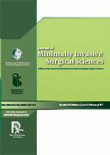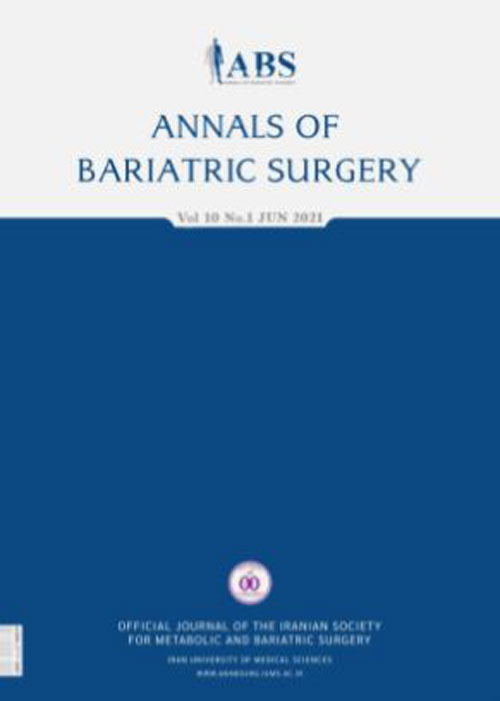فهرست مطالب

Annals of Bariatric Surgery
Volume:6 Issue: 1, Winter 2017
- تاریخ انتشار: 1395/12/11
- تعداد عناوین: 5
-
-
Page 2BackgroundLaparoscopic appendectomy (LA) has become the standard choice for acute appendicitis. Several techniques to close the appendiceal stump were investigated, and use of polymeric clips, are shown safe and cost effective.ObjectivesEvaluation of the efficacy and safety of appendiceal stump closure with polymeric clips in LA.MethodsThis is a retrospective cohort study included 35 patients who underwent LA, between April 2013 and August 2016 in Rasool-e-Akram university hospital. appendiceal stumps ligation were performed by polymeric clips. One month follow up after surgery was performed for all patients. Demographic information of patinets, surgery, complications, readmission and pathological reports, were collected from medical records and data base.ResultsThirty-five patients were included in this retrospective study. Nineteen patients were male and 16 patients were female (54.3% vs 45.7%). The mean age was 28.49 ± 9.56 years, mean operative time was 59.6 ± 11.8 minutes and mean hospitalization was 2.54 ± 0.7 days. There was no intraoperative complication and intraabdominal abscess formation. Also no readmission and no perioperative death were recorded in documents. In pathologic reports, there were 15 (42.8%) suppurative and one gangrenous (2.8%) appendicitis.ConclusionsApplication of polymeric clips for stump ligation is safe, cost effective and time saving, and could be used as favorable technique in LA.Keywords: Laparoscopic Appendectomy, Polymeric Clips, Hemolock, Stump, Ligation, Appendicitis
-
Page 3BackgroundTo date, little is known about neuromuscular blockade (NMB) and its impact in bariatric surgery and patient recovery. The goal of this study was to better assess the relationship between depth of NMB, bariatric surgeons satisfaction, and the quality of patient recovery.MethodsBetween January and September 2015, we did a prospective observational study of 50 morbidly obese patients undergoing elective laparoscopic sleeve gastrectomy (LSG) under general anesthesia at our ambulatory surgical center. Rocuronium was used for tracheal intubation with bolus doses to maintain NMB. NMB was monitored at 5 minute intervals during the surgery, and at 30 second intervals following the reversal agent. The surgeon was blind to all anesthesia procedures and scored the surgical working conditions at 15 min intervals. Demographic data, operative data, and conditions were analyzed.Results42 females and 8 males, with a mean age of 38.8 years (range: 19 to 60, standard deviation (SD): ± 9.2), and mean BMI of 43.9 (range: 36 to 58, SD: ± 5.1), underwent a LSG. Mean total surgical time was 63 minutes (range: 35 to 128). During the laparoscopic part of the surgery, 22% of the patients were in deep block and 78% were in moderate block. Six patients presented poor or extremely poor surgical conditions, and 6 patients had a sudden increase in intra-abdominal pressure. None of these patients were in deep block at that time. Patients in deep NMB had a shorter laparoscopic time (37 minutes, SD ± 7.1 vs 53 minutes, SD ± 18.3; P = 0.006).ConclusionsThis study found that deep NMB prevents inappropriate abdominal cavity movement, consequently improving the operating area and the surgeon satisfaction.Keywords: Ambulatory Surgical Procedures, Bariatric Surgery, Length of Stay, Satisfaction, Neuromuscular Blockade
-
Minimally Invasive Video-Assisted Thyroidectomy (MIVAT) in the Era of Minimal Access Thyroid SurgeryPage 4BackgroundIn the era of minimal access thyroid surgery, the terms minimal access and minimally invasive are often used interchangeably and in most instances this is far from being accurate. The aim of this article is to examine the characteristics and potential of one of the first minimal access thyroid procedures described; minimally invasive video-assisted thyroidectomy (MIVAT).MethodsThe purpose of this article was obtained by almost two decades of experiences with the procedure at the authors center, and a systemic literature review was undertaken of all available medical literature to evaluate available literature by conducting a PubMed search limited to articles originally written in English language between the years 1997 and 2016. The search was limited by using the terms: minimally invasive thyroid surgery, video-assisted, endoscopic, and robotic thyroidectomy. The procedures design, radicality and safety, learning curve, cost, advantages and disadvantages were addressed. MIVATs potential as a surgical tool for thyroid pathology was also addressed by evaluating its indications, contraindications, and limitations.ResultsMIVAT is a gasless hybrid procedure that is comparable to conventional thyroidectomy (CT) in terms of radicality and safety, with the added advantage of reduced early postoperative voice and swallowing symptoms. MIVAT has a relatively rapid learning curve with an additional advantage over other minimal access procedures; the ability of being adopted by the low-volume surgeon at a cost and time comparable to CT, but with improved patient satisfaction. Furthermore, it is non-inferior to procedures free of a neck scar in terms of patient satisfaction. MIVATs main drawback is that it is limited by its strict selection criteria. It is a viable treatment option for all types of thyroid pathologies. However, its role in therapeutic neck dissection remains to be validated.ConclusionsMIVAT is a safe and effective procedure which is obviously described in its name minimally invasive. It seems that in the era of innovative technologies and scarless-in-the neck thyroid surgery, MIVAT is here to stay.Keywords: Minimally Invasive Thyroid Surgery, Video, Assisted Thyroidectomy, Endoscopic Thyroidectomy, Robotic Thyroidectomy
-
Page 5IntroductionKlinefelter syndrome is a disorder of chromosomes in which common karyotype is (47XXY). Hypogonadism, gynecomastia and azoospermia could be detected in this syndrome. Decreased basal metabolic rate and interest in activities, loss of muscle mass, weight gain, the deficiency of sex hormone and mood changes cause obesity which cause morb obese in this case.Case PresentationA 34-year-old morbid obese (BMI = 60.40) male was come to the Laporoscopy research center of Iran University of Medical science at 26 January 2016. He was diagnosed as Klinefelter syndrome by genetic testing (47XXY karyotype). He reported suffering from knee cellulitis, headache, low back pain and varices. His nutrition habits was fast eating, Sweet eating and Snack eating. The beginning of his obesity was in his childhood. The best treatment for his obesity and its side-effects is altering in his life style, low calorie diet. Finally, if these methodes fail to lose weigth, bariatric surgery is suggested.ConclusionsIn morbid obese patients apporopriate diet, change in calorie intake and life style should be considered as a first line of treatment and finally, surgery may be an option to treat obesity. These two methodes can often help reduce the risk of other diseases (e.g., diabetes, heart disease, and sleep apnea) that are associated with severe obesity.Keywords: Klinefelter Syndrome, Morbid Obesity, Bariatric Surgery, Case Report


